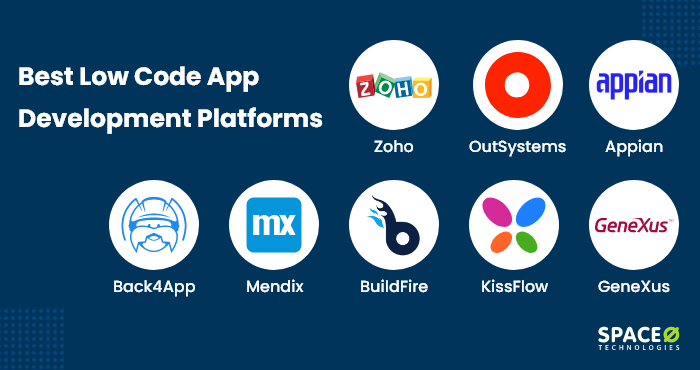Recommended Advice For Selecting Low-Code Platform Recommendations
Recommended Advice For Selecting Low-Code Platform Recommendations
Blog Article
Benefits Of Low-Code Development For Non-Developers In Terms Accessibility
Due to several factors due to a variety of factors, low-code development is easier to non-developers. These are sometimes referred to as "citizens developers."
Drag-and-Drop Builders: Low-code systems provide drag-and-drop interfaces that allow non-developers, without the necessity of writing code, to create visually appealing applications. The development process is now more accessible for those who have no technical background.
WYSIWYG editor: The "What you see is the result you will get" editors allow users to create interfaces, workflows and other features in a manner that closely mimics the final result. They are easier to learn and make use of.
Simplified Workflow and Logic Design:
Visual Workflow Design: Users can quickly design business processes and application logic with diagrams, models, and flowcharts. They are easier to work with than traditional programming.
Pre-built Logic Components: Low-code platforms usually contain pre-built logic components (e.g. statements that are conditional loops) that are easily set up, reducing the need for complicated programming.
Reusable templates and components:
Library of Pre-built Templats: A lot of Low-Code platforms provide a collection of templates that are based on common application types. Non-developers will be capable of modifying the templates as needed.
Reusable modules and widgets: The process of creating a website is simplified by using reusable components and modules. This reduces the need for deep technical knowledge.
Guided Development Tutorials and Guided Development
Step-by-step guides Platforms offer tutorials, tips and tricks on the screen and guided development paths to assist non-developers in creating applications.
Interactive Tutorials: Interactive and hands-on tutorials let users learn by doing. They gain confidence by making use of the platform.
Integration with existing tools:
Easy integration Low-code platforms are developed to integrate seamlessly with the existing business tools and systems (e.g. ERP, CRM) allowing non-developers create applications within their current workflows.
APIs/Connectors: The APIs/Connectors built-in allow non-developers to connect their apps to other services.
Collaboration Features:
Team Collaboration Real-time collaboration, shared workspaces, and shared workspaces permit business analysts, non-developers and other stakeholders to effectively collaborate with developers who are professionals.
Access Control Based on Roles: Developers who are not developers are able to have access to roles and levels of access that allow users to contribute, without compromising security or functionality.
Automated Tests and Debugging
Low-code platforms are often equipped with testing and debugging software that can automatize these processes. This makes it easier for non developers to verify the functionality of their apps.
Error Highlighting When errors occur the platform highlights them and suggests possible fixes. It guides non-developers in troubleshooting.
Low-code development is easier for non-developers to access because it democratizes the development process. Low-code platforms provide intuitive, visual tools, guided experiences, and let business users actively participate in developing apps, maintaining them and updating them. Take a look at the best from this source about Low-code Platform for application development for website tips including push notifications android, jdbc server, multiplatform mobile app development, build a docker container, jdbc server, rapid application design, application modernization, rad development, stored sql procedures, push alerts and more.
Low-Code Software Is Cost-Effective.
Low-code development offers a number of advantages when it comes to cost-effectiveness. Businesses that are seeking to reduce costs can benefit from this option while delivering quality applications. The main benefits are: Reduced development costs
Lower Coding Requirement: Low coding platforms eliminate the requirement to write code manually and save developers time as well as money. This results in lower costs of labor.
Reduced Developer Resources: Since low-code is faster and simpler to create, less skilled developers will be required. The cost of hiring and staffing could be drastically reduced.
Speedier Time to Market
Accelerated Cycle of Development Visual tools for low-code platforms and components allow for rapid application creation, which lets businesses launch their new products quicker. This could result in faster revenue growth and better competitive positioning.
Rapid prototyping: By creating rapid prototypes and testing them quickly companies can decrease the time they devote to the process of development and allow for quicker iterations on the basis of user feedback.
Reduce the cost of maintenance
Simple Maintenance: Applications developed using low-code platforms are generally easier to maintain due to their modular components and standard architecture. Maintenance and support costs are reduced.
Automated Updates: A lot of low-code software platforms manage patches and updates automatically, ensuring applications remain secure and up-to date without needing large manual intervention.
Efficient Resource Utilization:
Low-code platform contributions allow business users as well as others who are not developers to take part in the process of creating. This allows companies to tap into the expertise of a wider range of employees, thus reducing dependence on highly-paid developers.
Optimized use of IT resources IT departments are given the chance to concentrate on more strategic projects instead of being bogged-down with simple work tasks for development. Overall efficiency and productivity improves.
The Scalable Pricing model
Subscription-Based Pricing: A lot of low-code software providers offer flexible subscription-based pricing plans that grow according to usage. This allows businesses to be able to align their spending with the actual demands and growth while avoiding large initial costs.
Pay-Assosiated Option: A few platforms offer pay-assosiated alternatives. They ensure that businesses pay only for the resources utilized and are beneficial for small and new businesses with limited funds.
Reduction in Third-Party Software Costs:
Built-in Functionalities: Low-code platforms often come with built-in functionalities and integrations that minimize the requirement for third-party software and tools resulting in cost savings on licensing fees and subscription fees.
Pre-Built Integrations: The possibility of having pre-built integrations with the most popular services and systems reduces the need for custom-designed development. Savings on both time and money.
Improved ROI
Faster Return On Investment: The combination of speedy development and lower costs with speedier time to market allows businesses to get a more return on their investment.
Increased Agility: Companies are able to swiftly adapt to changes in market and to changing customer demands. This helps them remain current and take advantage of opportunities that arise.
Reduced Training Costs
User-Friendly Interfaces: The user-friendly interfaces and user-friendly features of low-code platforms help to reduce the learning curve thereby eliminating the need for intensive training.
Accessible resources A lot of low-code platforms offer complete tutorials, instructional materials, as well as community support and help, which can reduce the need for formal training.
Collaboration can be made more efficient.
Improved Collaboration Tools Collaboration tools are integrated into the workflow. This allows more effective communication between team members and an improvement in overhead for projects.
Unified Development Environment. An unified development platform helps reduce costs and streamline workflows by reducing the complexities of managing multiple tools.
Low-code development is cost-effective because it decreases maintenance and development costs. It also reduces the time to market and maximizes the use of resources. Pricing models can be adapted. These elements provide substantial financial benefits to business and make low-code an attractive option for businesses seeking to maximize their budgets and create robust, scalable, high-quality applications. Follow the top Enterprise application development with Low-code Platform blog for website info including azure sql, rad application development, develop web application, app modernization, rapid app development, cross platform mobile dev, app modernization, build with docker, build a docker container, low code platforms and more.
Advantages Of Low-Code Application Development In Terms Of Vendor Support And Community
Low-code application development platforms have major advantages in terms the support provided by vendors and communities. These is essential to ensure the success of implementation, continuous maintenance and constant improvement of applications. Here are a few of the advantages.
Comprehensive Technical Support:
Support Teams with Dedicated Support Numerous low-code platforms provide dedicated support teams who can assist with technical issues, problem solving and advice. This will ensure that any issues are swiftly solved.
Help is accessible 24/7: Many vendors provide around-the-clock assistance that can be especially helpful for businesses operating in multiple time zones.
Onboarding and Training:
Vendors will often offer organized programs for users, such as tutorials and webinars. They might also offer certification courses.
A lot of vendors offer personalized onboarding that helps customers to utilize the platform effectively and customize it to meet their requirements.
Regular Updates and Enhancements:
Continuous Improvement : Low-code platform manufacturers often release regular updates that include new functionality as well as performance improvements and security patches. These updates make sure that their platform remains up to date and secure.
Feedback integration: Vendors often incorporate user feedback into their process of development to ensure that the platform is able to meet the changing demands of their users.
Comprehensive Documentation:
Documentation: Detailed documentation is provided for the majority of products. It covers everything from the basics to the most advanced customisation. This can help users find solutions on their own.
API References: Comprehensive API documentation aids developers to integrate the low-code platform into other systems and customize their applications efficiently.
Professional and Consulting Services
Expert Consultation : Vendors offer consultation services such as designing architecture and complex implementations. They offer this service in order to make sure that their users are able benefit from the platform.
Custom Development Services Some vendors provide customized development services for specific features or integrations not available in the box.
Community Support
Active User Communities
Forums and Discussion Panels: A lot of Low-code platforms offer lively online communities where users can ask questions, debate strategies, and even collaborate with each other on best methods.
User Groups & Meetups: Local or virtual user groups and meetings provide opportunities to learn, network and sharing your experiences.
Collaboration and knowledge sharing:
Community-Contributed Resources: Users often share templates, modules, and extensions that they have developed, which can be reused or adapted by others, accelerating development and innovation.
Crowdsourced Solution Finding: The collective wisdom and experience of a group could be an excellent resource for finding solutions to complex problems.
Learning and Development
Community-Led Learning: Many communities hold training sessions, workshops and webinars which are typically run by experienced users who can provide insights and techniques that are more advanced.
Online Courses and Tutorials Community members regularly develop and publish online courses, tutorials and how-to guides, improving the learning resources that are available to all users.
Feedback and Influence
Product Feedback: Many forums have channels for giving feedback to manufacturers. This can influence the development of new features and enhancements.
Beta Testing Programmes Members of the community who are active may be able to participate in beta-testing programs. This gives them an early view on the latest features, as well as the chance to influence the platform’s evolution.
Recognition and Support
Community Recognition Programs: Many companies offer recognition programs to active members of the community. Examples include MVP (Most Valuable Professionals) that recognizes contributions of the community.
Peer Support. Community members provide peer-to-peer support. They share their knowledge with new users and provide guidance. This creates an atmosphere of collaboration and support.
Overall the combination of strong vendor support and an active, engaged community provides a comprehensive support ecosystem for low-code application development. The developers will benefit from the experience and resources to develop, deploy and maintain their application.